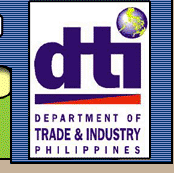| DTIís
program on the setting-up Consumer Welfare Desks ( CWDs ) is
gradually gaining the support of the business community because of
the tremendous benefits these desks give, not only to consumers
but to the business establishments as well.
Business firms are
encouraged to develop comprehensive complaints-handling programs
like the CWD. These will enable them to operate quickly and
inexpensively, as well as promote consumer patronage.
Advantages of
Setting Up CWDs:
- Effective
Selling Technique
Looking for new techniques or come-ons to attract customers?
One proven strong selling point is by making prospective
customers aware that your firm has set up a Consumer Welfare
Desk that will address their needs.
- Promote
Customer Satisfaction
Reputable firms attest to the fact that consumers who
complained about their problem and received satisfactory results
exhibited the highest degree of continued patronage. Hence,
these firms welcome complaints.
- Complaints as
Built-in Warning Signs
Consumer complaints serve as early warning signs that your
business may be, just may be, violating some fair trade laws and
provide you with an excellent opportunity to correct the problem
as soon as it crops up.
- Source of
Valuable Information
In lieu of market surveys which are costly, information
gathered through your CWDs can help you evaluate the quality of
your products as well as the service and public relations
practices of your personnel.
- Enhances
Business-Government Relations
A well-managed CWD will enhane the relationship between the
regulating government agencies and the business establishment.
In fact, your efficient handling of consumer complaints is the
big load off the shoulders of government agencies.
The following is a
checklist of procedures in setting up the CWDs:
Consistency
- Set up uniform
producers for receiving, recording
and resolving complaints. It is advisable to
put your companyís policy in writing. Give specific
guidelines to employees assigned to man the CWD and spell out
how much discretion they can exercise for specific cases.
- The CWD
ensures the consumers are not referred from one person to
another. In other words, the buck should stop at the CWD.
- Provide
standardized complaints form to ensure that all necessary
information are elicited from the complainant, whether
complaints are received by mail, telephone or walk-in.
- If necessary,
conduct training seminars to improved the staff's skills in
handling complaints. Train your personnel to handle complaints
courteously and fairly.
- Monitor the
procedure to find out how effective the system is.
Accessibility
- Announce to
the public the presence of the CWD in your store.
- Set up the CWD
in a conspicuous place.
- Make the
complaint-filing procedure simple, clear and convenient.
Assure the consumer that complaints are accepted during
business hours, whether complaints are filed personally or by
phone.
- If supervisors
are needed to handle complaints outside the CWDís
jurisdiction, make sure these supervisors are available at all
times.
- Make sure that
the consumerís first impression of your storeís
complaints-handling procedure is positive, not negative.
Objectively
Give the consumer
an opportunity to present her side. Many small problems can be
prevented from developing into big ones if you have a
knowledgeable person assigned to man the CWD.
Promptness
- Try to resolve
complaints as fast as possible. The longer it takes you to
resolve a complaint, the more time you lose precious business
hours and the more likely will your frustrated customer
patronize other stores in the future. Consumers will appreciate
your quick response even if all you do is acknowledge and
receive the complaint.
- When an
immediate written response to a complaint is necessary, use
telegram.
Monitoring/Recording/Follow-up
- Data and
information gathered from CWD records can be extremely helpful
to the business in a number of ways: A systematic analysis of
complaints can help you identify specific problems regarding
your products, suppliers or employees and help you avoid the
same problem in the future.
- Follow-up and
record-keeping can identify bottlenecks and show consumers that
their feed backs are important.
 |
